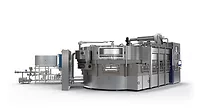Craft beverage trends impact can filling, seaming equipment
Equipment manufacturers tailor products to fit craft needs

As consumers’ lifestyles only become busier, beverage-makers are turning to convenient, on-the-go packaging options to coincide with this new trend. Whether it’s carbonated soft drinks (CSDs), craft beer or wine, convenient, sustainable options like aluminum cans, are providing can filling and seaming manufacturers a path for innovation.
An infographic from the Washington, D.C.-based Can Manufacturers Institute (CMI) titled “The Economic Impact of the Aluminum Can Industry in the U.S.” notes that the total impact of beverage cans within the beer and soft drink industries equates to $71.8 billion of economic impact and 82,821 jobs. There are 96 billion cans (including food, beverage and aerosol) produced every year, it says.
Additionally, the primary packaging format continues to resonate with today’s consumers. Sixty-nine percent of survey-takers said they prefer cans because they are colder and more refreshing, CMI data states. Sixty-eight percent said they prefer cans because they are easy to grab on-the-go, and 67 percent said they prefer cans because they are easier to carry and harder to damage compared with other packages, according to the association.
Consumers also gravitate to aluminum cans for their sustainable benefits. More than 80 percent of consumers said the infinite recyclability of cans matters to them, and seven-in-10 adults said they purchase a product because its packaging is better for the environment, CMI data states.
As aluminum cans maintain their status with consumers, it is having a larger impact on original equipment manufacturers (OEMs). Within the past year, the can filling and seaming industry has seen a substantial increase in the demand for canned craft beverages, as well as an increase in demand for cans of different sizes, notes John Wagg, global sales manager at CMC-Kuhnke Inc., Albany, N.Y.
“There has been a proliferation of companies jumping into the canning/filling market,” he says. “With so many new companies producing filling/seaming machines, the need to monitor the products coming off these machines has become increasingly important.”
Sealing the solution
As the demand for canned beverages increasingly becomes more popular, craft brewers are turning to OEMs who can meet consumers’ social lifestyle needs with their craft beverage preferences. Can filling and seaming manufacturers have had to innovate their offerings to match these new trends, experts note. “Being able to take craft beer to places off-limits to glass is still creating a huge push in this industry,” says Barry Fenske, director of filling technology at Franklin, Wis.-based Krones Inc.
“This misconception that you don’t put craft beer in cans has been put to rest,” he continues. “A huge uptick in requests for information and pricing has occurred in the last three to four years and is still ongoing.”
Because of the increased demand in their products, craft beer manufacturers have specific requirements that need to be met by equipment companies. Those in the industry generally are looking for machinery solutions that are sustainable and fairly priced, but still provide quality performance.
An important aspect in quality performance during filling and seaming is the oxygen pickup in the closed container, Fenske explains.
“Making machines smaller [and] less expensive, while maintaining the same oxygen pickup guarantees and reduces changeover times,” he says. “This is becoming the next big push.”
To achieve the above, can fillers and seamers have done just that, Fenske notes. “Making [the machines] smaller, stripping away the bells and whistles to get them to a price level customers can afford, but you keep the same filling valve technology,” he says.
For the craft beer industry, Krones offers the Craftmate, a volumetric can filler specifically designed for the market. “From 80 [cans per minute] (cpm) [to] 2,200 cpm, with an oxygen pick-up guarantee that protects the customers’ package,” he says. “Our most recent addition is the Craftmate can filler for craft brewers —[it offers] a smaller footprint and is less expensive to fit that 80-250 cpm need when they are ready to step up from an inline solution doing 30 cpm.”
The Craftmate offers innovative technology including electropneumatically controlled filling valves, a compact design, easy machine clean-up and double flexibility designed to fill CSDs and beer, the company’s website states. The machine also offers the ability to fill various can sizes and formats, it states.
Also designed for the craft beer industry, the Innofill CAN Compact, a series of can-fillers intended for small- to medium-sized companies, is manufactured by Dortmund, Germany-based KHS Group and KHS USA Inc., Waukesha, Wis. The Innofill CAN Compact is designed for low- to-medium outputs of 10,000 to 48,000 cans an hour, the company says.
“With its efficient CO2 purging systems, the machine enables extremely low oxygen pickup,” said Manfred Härtel, filling product manager for KHS, Bad Kreuznach, Germany, in a statement. “Thanks to its patented purging process, it also consumes about 30 percent less carbon dioxide than conventional systems. Craft brewers can now also profit from this feature with the compact version. The demand for an adapted model for smaller filling quantities is rising in particular among the producers of high-quality, individual beers in the USA where the craft brewing scene has been well established for many years now.”
Measuring can seams
In addition to machinery designed for low oxygen pickup, the need for accurate double seam measurements is becoming important for many beverage producers, CMC’s Wagg notes.
“Double seam inspection technology continues to make advancements,” he explains. “Traditional destructive systems have improved with high-definition cameras and new innovative software. The introduction of non-destructive double seam technology is giving beverage producers an easy and efficient way to measure double seams.”
The company offers double seam inspection equipment and seamer set up gauges, that allows beverage producers to check double seams without destroying the package or product, Wagg says.
CMC-Kuhnke also developed doubleseam.com, an online troubleshooting guide that offers a glossary of terms and topics related to the seaming industry, as well as abbreviations, dimensions and evaluation guidelines for craft brewers who are using that particular equipment, it says.
Before beverage-makers choose their filling and seaming equipment, they should keep a few considerations in mind, experts note. “[Beverage-makers should consider] who can fill their product and protect its integrity,” Krones’ Fenske says. “It’s all about shelf life and who can support the equipment in a timely manner.”
Just purchasing the can filler/seamer is not enough, CMC’s Wagg explains. “Beverage producers need to look at the total investment, including [quality assurance] equipment and other peripheral equipment. Especially true for those new to packaging, finding a real partner — with a commitment to service — is crucial.”
Sustainability also plays a pivotal role in can filling and seaming equipment. “[It’s] the same as every other industry,” Krones’ Fenske says. “More with less is always on the minds of customers and it is more of an ingrained idea in design nowadays, not just a separate topic that gets its own focus.”
In the future, consumers might start to see water packaged in cans, as aluminum is easier to recycle than plastic, he notes. “Honestly, the innovation is there,” Fenske says. The issue is the same that clouded the craft beer [industry] for years. You don’t [package water] in cans. Maybe that mindset will change.” BI
Looking for a reprint of this article?
From high-res PDFs to custom plaques, order your copy today!





